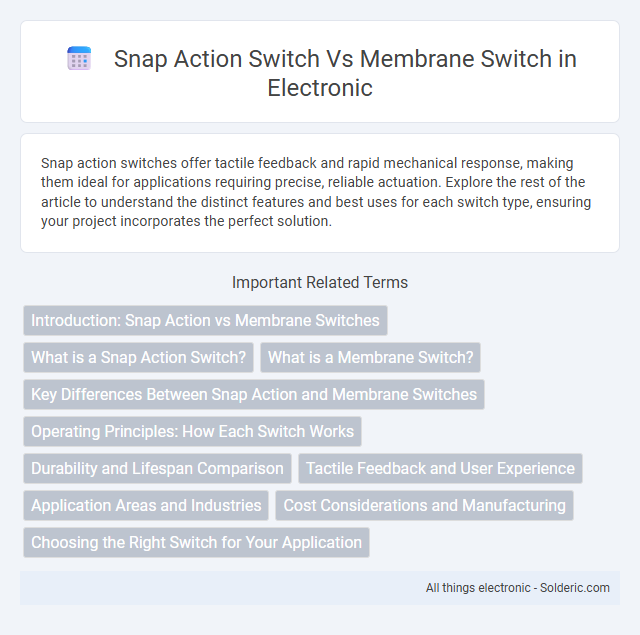Snap action switches offer tactile feedback and rapid mechanical response, making them ideal for applications requiring precise, reliable actuation. Explore the rest of the article to understand the distinct features and best uses for each switch type, ensuring your project incorporates the perfect solution.
Comparison Table
| Feature | Snap Action Switch | Membrane Switch |
|---|---|---|
| Operation Mechanism | Mechanical movement with a snap action for quick response | Pressure-sensitive layers activating electrical contacts |
| Durability | High mechanical durability, can withstand millions of actuations | Moderate durability, dependent on surface wear and environment |
| Sensitivity | High tactile feedback with audible click | Low tactile feedback, quiet operation |
| Design | Bulky mechanical components, limited in customization | Thin, flexible, customizable graphic overlays |
| Cost | Generally higher due to mechanical parts | Lower manufacturing costs |
| Applications | Industrial controls, appliances, safety-critical systems | Consumer electronics, remote controls, medical devices |
| Environmental Resistance | Good resistance to dust and moisture when sealed | Excellent sealing, resistant to dust, moisture, and chemicals |
Introduction: Snap Action vs Membrane Switches
Snap action switches feature mechanical contacts that rapidly open or close circuits with a tactile "snap," ensuring reliable and precise electrical performance ideal for industrial and heavy-duty applications. Membrane switches utilize layered flexible materials with printed circuits, offering a low-profile, sealed surface suitable for consumer electronics and medical devices where durability and easy cleaning are essential. The choice between snap action and membrane switches hinges on factors like tactile feedback, durability, environmental resistance, and application-specific requirements.
What is a Snap Action Switch?
A Snap Action Switch is an electromechanical device designed for rapid transition between electrical contacts upon minimal physical force, ensuring precise and reliable switching. It operates with a spring mechanism that snaps the contact arm from one state to another, providing consistent tactile feedback and longevity in industrial, automotive, and consumer electronics applications. Your choice of a Snap Action Switch guarantees swift response times and durability compared to membrane switches, which rely on flexible layers for activation.
What is a Membrane Switch?
A membrane switch is a thin, flexible interface that integrates circuit layers, allowing for sealed, durable, and cost-effective input controls. Unlike snap action switches, which rely on mechanical movement and tactile feedback, membrane switches operate through pressure-sensitive layers that register commands without physical clicks. Your choice depends on application needs such as environmental resistance, lifespan, and tactile response required.
Key Differences Between Snap Action and Membrane Switches
Snap action switches provide tactile feedback through a physical mechanism that rapidly changes state when pressed, making them ideal for applications requiring precise user input. Membrane switches use a flexible, flat design with printed circuits layered beneath a protective membrane, offering a compact and waterproof interface suitable for harsh environments. Your choice depends on whether you prioritize tactile response and durability (snap action) or a thin, sealed surface for easy cleaning and reliability (membrane).
Operating Principles: How Each Switch Works
Snap action switches operate using a mechanical spring mechanism that rapidly changes state when a certain force threshold is reached, providing tactile feedback and reliable electrical contact. Membrane switches function through a flexible, pressure-sensitive layer that completes an electrical circuit by pressing conductive traces together, enabling low-profile, sealed designs ideal for harsh environments. The distinct operating principles influence durability, responsiveness, and application suitability in various electronic devices.
Durability and Lifespan Comparison
Snap action switches offer superior durability with mechanical parts rated for millions of cycles, making them ideal for high-use applications requiring reliable tactile feedback. Membrane switches, constructed with flexible layers and printed circuits, typically have a shorter lifespan around a few hundred thousand cycles but excel in resistance to environmental factors like moisture and dust. The choice between the two hinges on balancing long-term mechanical endurance against environmental resilience and design flexibility.
Tactile Feedback and User Experience
Snap action switches provide distinct tactile feedback through a mechanical click, enhancing user confidence and accuracy during operation. Membrane switches offer a softer, quieter touch with less pronounced feedback, which may lead to less precise input but improved durability and ease of cleaning. Your choice between these switches impacts the overall user experience by balancing responsiveness and maintenance needs.
Application Areas and Industries
Snap action switches are widely used in industrial machinery, automotive systems, and household appliances due to their durability and precise tactile feedback, making them ideal for heavy-duty and high-reliability applications. Membrane switches find extensive applications in medical devices, consumer electronics, and control panels, favored for their low profile, flexibility, and resistance to environmental factors such as moisture and dust. Both switch types serve distinct industry needs: snap action switches excel in environments demanding robust mechanical performance, while membrane switches are preferred in ergonomic, space-saving, and sealed applications.
Cost Considerations and Manufacturing
Snap action switches generally incur higher manufacturing costs due to their mechanical components, precise assembly, and more robust materials required for durability. Membrane switches offer cost advantages with simpler construction, lower material expenses, and easier mass production through printed circuit technology. Choosing between them depends on budget constraints, production volume, and application-specific durability requirements.
Choosing the Right Switch for Your Application
Choosing the right switch for your application depends on factors like durability, tactile feedback, and environmental resistance. Snap action switches offer precise mechanical actuation with high reliability and long life cycles, making them ideal for industrial and automotive uses. Membrane switches provide a low-profile, sealed design that is resistant to dust and moisture, suited for consumer electronics and medical devices where sleek interfaces are essential.
Snap action switch vs Membrane switch Infographic

 solderic.com
solderic.com